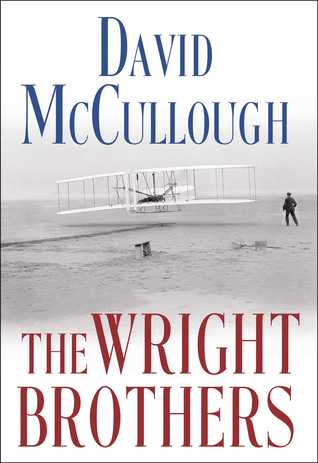The Wright Brothers
by David McCullough
Among the many intriguing stories and historical notes in the New York Times Best Seller The Wright Brothers (Simon & Schuster, 2015), by David McCullough, there is this bit of information: Even though the motto of the state of North Carolina is “First In Flight,” the Wright brothers were not natives or even long-time residents of North Carolina. For Wilbur, (April 16, 1867–May 30, 1912) and Orville (August 19, 1871–January 30, 1948) Wright, Dayton, Ohio, was home. Dayton is also where they designed and built their historically important airplane, the Wright Flyer. The ordinary Midwestern town of Dayton figures more prominently in the Wright brothers’ lives, and in McCullough’s book, than any other city in which the Wright’s made flight-history — and there were many such cities, both in the US and in Europe.
The Wright Brothers is actually three books in one: it is a history of modern aviation, and it is the biographies of Wilbur and Orville Wright. As complicated as it must have been to organize all the threads of information, McCullough’s skillful and winsome way of braiding the three stories together makes reading The Wright Brothers a thoroughly gratifying experience. In truth, the Wright brothers are so connected with modern aviation that the narrative of manned flight in the late nineteenth and early twentieth century cannot be told without them. And similarly, so close was the relationship of Orville and Wilbur that there would be no telling the life story of one without the other, as this quote illustrates:
“As others in Dayton knew, the two were remarkably self contained, ever industrious, and virtually inseparable. ‘Inseparable as twins,’ their father would say, and ‘indispensable’ to each other.
“They lived in the same house, worked together six days a week, ate their meals together, kept their money in a joint bank account, even ‘thought together,’ Wilbur said… Not that things always went smoothly. They could be highly demanding and critical of each other, and disagree to the point of ‘shouting something terrible…’ As was said, neither ever chose to be anything other than himself, a quality that rated high in Ohio. Not only did they have no yearning for the limelight, they did their best to avoid it. And with the onset of fame, both remained notably modest.”
The Wright Brothers is a book about how the extraordinary is contained within the ordinary. For the Orville and Wilbur, their ordinary lives included:
- An itinerant clergyman father, Bishop Milton Wright, and a mother with a mechanical aptitude. McCullough says,”[Susan Koerner Wright was] a regular genius in that she could make anything, and toys especially, even a sled, ‘as good as a store kind…’ “
- Siblings – Wilbur and Orville had two older brothers and a younger sister.
- A large family library. “The Wright family book collection… was neither modest nor commonplace… Everyone in the house was reading all the time,” writes McCullough.
- A high school education, although neither received diplomas.
- The friendly city of Dayton, Ohio
The extraordinary character and intelligence that was contained within the ordinary lives of Wilbur and Orville developed into resoluteness: “What the two had in common above all was unity of purpose and unyielding determination. They had set themselves on a ‘mission,’ ” McCullough records.
With their mission in place, the Wrights developed these extraordinary skills:
A strong entrepreneurial spirit: They built a printing press and started their own newspaper; they followed this with a printing shop. Then, being aware of the bicycle craze that was occurring across the US, Wilbur and Orville opened a bike store where they sold and repaired bicycles. This store was also the site where they the learned mechanical skills to build their plane.
The ability to persist despite criticism and failure: After they had built the first glider and began their lackluster flying experiments in the Outer Banks of North Carolina, the boys were observed by the locals as they watched birds in the air. The author records one Outer Banks man as saying, “We couldn’t help thinking they were a couple of nuts. They’d stand on the beach for hours at a time just looking at the gulls flying, soaring, dipping.”
The courage to start again: The Wrights were greatly discouraged after realizing, through experimentation, that almost everything in engineering books relating to controlling a glider in flight was incorrect. About this troubling situation, says McCullough, “Orville wrote, ‘We had to go ahead and discover everything ourselves.’ ” Which they did! At home in Ohio, the brothers invented the controls for steering their glider as well as inventing a suitable motor to supply the power needed for flight.
On December 17, 1903, close to Kitty Hawk, North Carolina, Flyer 1 was successfully flown by Orville for 12 seconds, and a distance of 120 feet. This was the beginning of the modern era of flight. But McCullough doesn’t end the story there. He goes on to relate the slow acceptance of the Wright brothers’ invention by the US government and the ridicule the Wrights suffered from the press and scientific communities around the world, most of which dismissed their flying experiments as bogus. McCullough clearly reports the struggles and setbacks the Wrights faced as they engaged the inventive process. This adds a striking level of tension to the narrative, thus making the Wright Brothers’ accomplishment, although expected by the reader, appear as the triumph it truly was.
You have likely heard the maxim, “Nothing is ordinary.” The Wright Brothers by David McCullough proves this saying is true by showcasing the lives of two ordinary young men from an ordinary American town, who, by their extraordinary accomplishments, changed the world.

